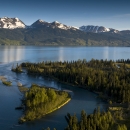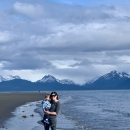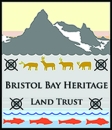The mission of the Alaska Coastal Program is to conserve healthy coastal ecosystems for the benefit of fish, wildlife, and people. As a direct conservation assistance program, the Alaska Coastal Program invests funding, staff time, technical expertise, and other resources into coastal habitat conservation projects in partnership with non-governmental organizations, private landowners, local governments, state agencies and Alaska Native organizations.
In Southcentral Alaska, fish and wildlife are abundant; however, because the region’s human impact is concentrated in coastal areas, habitat degradation of coastal wetlands and estuaries can have a greater negative effect on fish and wildlife resources by degrading key habitats for anadromous fish or migratory birds. Land uses across the region are varied, including community/land development, oil and gas extraction, mining, timber harvest, tourism, recreation, and subsistence activities.
Example Project
The islands of Iliamna Lake in southwest Alaska contain some of the richest assemblages of fish and wildlife in the Nation. Alaska Native peoples in the region rely on this pristine landscape and its resources for their traditional way of life. Working with the Bristol Bay Heritage Land Trust and other partners, the Coastal Program helped conserve over 13,000 acres of coastal wetlands and shoreline.
Conservation efforts like this support tribal traditions in perpetuity as well as habitats that benefit harbor seal and salmon populations. The Bristol Bay watershed, in which Iliamna Lake lies, supports the world’s largest and most valuable sockeye salmon fishery. Preserving this lake will help sustain the $2.2 billion salmon industry which supports more than 15,000 fishing and processing jobs.




